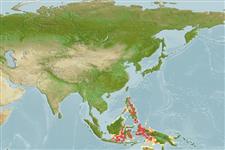Environment: milieu / climate zone / depth range / distribution range
Ecologia
marino associati a barriera corallina; non migratori; distribuzione batimetrica 5 - 33 m (Ref. 5222). Tropical; 20°N - 12°S, 111°E - 149°E (Ref. 5222)
Western Pacific: Philippines, Indonesia (Sulawesi, Flores), and Papua New Guinea.
Size / Peso / Age
Maturity: Lm ? range ? - ? cm
Max length : 25.0 cm TL maschio/sesso non determinato; (Ref. ); common length : 20.0 cm TL maschio/sesso non determinato; (Ref. )
Spine dorsali (totale) : 9; Raggi dorsali molli (totale) : 14; Spine anali: 3; Raggi anali molli: 8. Similar to the more common Cephalopholis spiloparaea but lacks banding in the caudal fin (Ref. 48635); characterized further by reddish brown color; base of pelvic fins with indistinct dark blotch; greatest body depth 2.5-2.9 in SL; rounded caudal fin; short pelvic fins, 2.3-2.5 in head length; strongly bilobed margin of front of upper lip (Ref. 90102); head length 2.1-2.3 times in SL; rounded preopercle, posterior edge finely serrate, lower edge fleshy; very convex upper edge of operculum; maxilla extends past eye; teeth large; midlateral-body scales ctenoid (Ref. 89707).
Inhabits protected or silty reef areas (Ref. 89707). Reported to be very habitat speciific, lives in very rich invertebrate habitat in the shore side of inner reefs and difficult to get shots u/w. Largest seen was about 25 cm, but usually smaller up to about 20 cm (R. Kuiter, pers. Comm. 03/2022). Maximum length given 40 cm TL (for confirmation) May undergo protogyny. Solitary (Ref 90102).
Life cycle and mating behavior
Maturità | Riproduzione | Deposizione | Uova | Fecundity | Larve
Heemstra, P.C. and J.E. Randall, 1993. FAO Species Catalogue. Vol. 16. Groupers of the world (family Serranidae, subfamily Epinephelinae). An annotated and illustrated catalogue of the grouper, rockcod, hind, coral grouper and lyretail species known to date. Rome: FAO. FAO Fish. Synop. 125(16):382 p. (Ref. 5222)
IUCN Red List Status (Ref. 130435: Version 2024-1)
Threat to humans
Harmless
Human uses
Pesca: di nessun interesse
Strumenti
Special reports
Download XML
Fonti Internet
Estimates based on models
Preferred temperature (Ref.
123201): 28 - 29.1, mean 28.5 °C (based on 68 cells).
Phylogenetic diversity index (Ref.
82804): PD
50 = 0.5000 [Uniqueness, from 0.5 = low to 2.0 = high].
Bayesian length-weight: a=0.01259 (0.00587 - 0.02699), b=3.04 (2.87 - 3.21), in cm total length, based on LWR estimates for this Genus-body shape (Ref.
93245).
Trophic level (Ref.
69278): 4.0 ±0.7 se; based on size and trophs of closest relatives
Resilienza (Ref.
120179): Medio, tempo minimo di raddoppiamento della popolazione 1.4 - 4.4 anni (Preliminary K or Fecundity.).
Fishing Vulnerability (Ref.
59153): Low vulnerability (15 of 100).
Nutrients (Ref.
124155): Calcium = 47.3 [25.4, 82.5] mg/100g; Iron = 0.488 [0.263, 0.915] mg/100g; Protein = 18.7 [16.9, 20.4] %; Omega3 = 0.16 [0.10, 0.26] g/100g; Selenium = 33.2 [15.9, 57.7] μg/100g; VitaminA = 108 [37, 349] μg/100g; Zinc = 0.835 [0.594, 1.369] mg/100g (wet weight);
